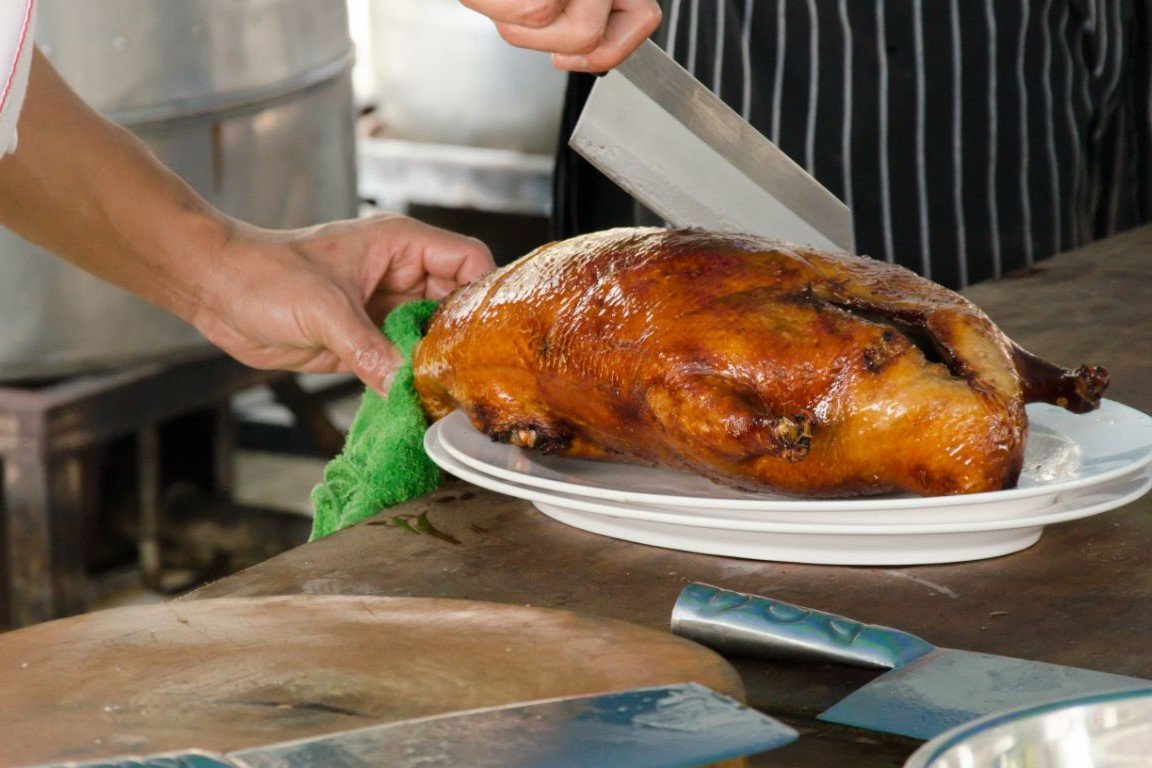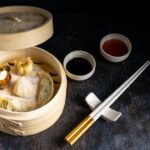Introduction to Peking Duck
Peking Duck is a renowned Chinese dish that has captivated food enthusiasts around the world. Originating from Beijing, this dish is celebrated for its crispy skin, tender meat, and rich flavor profile. Historically, Peking Duck dates back to the Imperial era, with records indicating its popularity during the Yuan Dynasty (1271-1368). The dish was esteemed not only for its taste but also for its elaborate preparation, which required precise techniques that have been passed down through generations.
Culturally, Peking Duck holds an exceptional place in Chinese gastronomy. It is often served during festive occasions, ceremonies, and banquets, symbolizing prosperity and good fortune. The meticulous process involved in creating this delicacy exemplifies the skill of Chinese culinary arts, showcasing the significance of food in social gatherings and celebrations. Traditionally, the preparation of Peking Duck involves air-drying the duck, followed by roasting it in a wood-fired oven. This method results in the signature crispy skin, which is further enhanced by glazing the duck with maltose syrup before roasting.
The essential ingredients contribute to the intriguing flavor of Peking Duck. Typically, the duck is seasoned with a blend of spices and herbs, and served with thin pancakes, hoisin sauce, and sliced scallions. Diners often enjoy assembling the dish themselves, layering the tender meat with crispy skin and garnishments in a pancake wrap. This interactive aspect of enjoying Peking Duck not only elevates the dining experience but also reflects the communal nature of Chinese meals.
As we explore faster, homemade variations of this traditional dish, it is important to appreciate the depth of preparation and cultural significance of Peking Duck. Understanding its roots paves the way for innovative adaptations that can be made in contemporary kitchens, allowing more people to experience this extraordinary dish at home.
Ingredients and Tools for Homemade Peking Duck
| Ingredient | Quantity |
|---|---|
| Whole duck | 1 (about 5-6 lbs) |
| Water | 2-3 quarts |
| Maltose | 1/4 cup |
| Honey | 1/4 cup |
| Soy sauce | 1/4 cup |
| Chinese five-spice powder | 1 teaspoon |
| Salt | 1 tablespoon |
| Rice vinegar | 1/4 cup |
| Scallions | 4 (for serving) |
| Cucumber | 1 (sliced thin, for serving) |
| Hoisin sauce | For serving |
| Pancakes (Chinese) | For serving |
Creating an authentic homemade Peking Duck requires a well-curated selection of ingredients and essential tools. At the heart of the dish is the star ingredient—a whole duck. Choosing a high-quality bird is critical; ideally, opt for a duck that weighs between four to five pounds. This weight ensures even cooking and succulent results. Additionally, familiarize yourself with the seasonings that enrich the duck’s flavor. Key ingredients include salt, five-spice powder, and sugar for the brine, which enhances the skin’s crispiness and the meat’s flavor profile.
In terms of sauces, hoisin sauce and plum sauce are paramount. These traditional accompaniments add depth and a sweet, tangy contrast to the dish. You may also want to prepare fresh vegetables, such as cucumbers and scallions, which are often served alongside the duck to add a refreshing crunch. Beyond the main components, a few careful selections of other ingredients are necessary for the complete experience, such as thin pancakes to wrap the slices of duck.
Equally important are the cooking tools that facilitate the Peking Duck preparation process. A sturdy roasting pan is essential to catch all the drippings during the roasting process while allowing for optimal heat circulation. Additionally, kitchen twine is necessary to help secure the duck’s legs and maintain its shape during cooking. For those seeking a quicker method, an air fryer can be a valuable asset, enabling the duck to cook evenly and yield crispy skin in less time. Other helpful tools include a sharp carving knife for precise slicing and a basting brush to apply the glaze effectively. With these ingredients and tools at your disposal, you are well on your way to mastering homemade Peking Duck.
Step-by-Step Process for Fast-Cooking Peking Duck
Step Description
1 Clean the duck and remove any excess fat.
2 Mix water, salt, and five-spice powder.
3 Immerse the duck in the mixture for about 30 minutes.
4 Rinse the duck and pat dry.
5 Mix maltose, honey, soy sauce, and vinegar; brush on the duck.
6 Hang the duck in a cool place to dry for 6-12 hours.
7 Preheat oven to 375°F (190°C).
8 Roast the duck for about 1.5 hours, until skin is crispy.
9 Let rest for 15 minutes before carving.
10 Serve with pancakes, hoisin sauce, scallions, and cucumber.
Peking Duck is a celebrated dish known for its crispy skin and succulent meat, traditionally requiring several hours to prepare. However, with some strategic techniques, you can achieve similar results in a fraction of the time at home. The first step in your fast-cooking journey is to properly prepare the duck. Begin by cleaning the duck thoroughly, removing any feathers and innards. Rinse it under cold water and pat it dry with paper towels to ensure a crisp finish.
Next, marinate and season the duck generously. For a traditional flavor, a mixture of soy sauce, honey, five-spice powder, and a splash of rice wine will infuse the meat with richness. Allow the duck to marinate for at least an hour, though overnight in the refrigerator is ideal. This resting period enhances the flavor and helps tenderize the meat.
When it comes to cooking, consider leveraging modern appliances such as an air fryer, which drastically reduces cooking time while producing that coveted crispy skin. If you opt to roast in an oven instead, preheat it to 375°F (190°C) and cook the duck for about 45 minutes, turning periodically to ensure even browning. The internal temperature should reach at least 165°F (74°C) for safety.
To achieve optimal crispiness, be attentive to moisture levels. It’s beneficial to dry the duck skin with a paper towel before cooking, as moisture can hinder crisping. Additionally, avoid overcrowding the air fryer or the roasting pan, as this can lead to steam buildup. Lastly, do not skip the resting period after cooking, which allows juices to redistribute. With these simplified steps and careful attention to detail, homemade Peking Duck can be both fast and flavorful, making it an enjoyable dish to prepare.
Serving Suggestions and Pairing for Peking Duck
When serving homemade Peking Duck, presentation plays a crucial role in enhancing the dining experience. Traditionally, Peking Duck is served with thin, steamed pancakes, which serve as the base for the succulent duck. To assemble, diners should slice the crispy duck skin and tender meat, placing them within a pancake along with finely sliced cucumber and green onions. These elements add freshness and texture, complementing the rich flavors of the duck.
Enhancing the dish further, various sauces can be offered to cater to different palates. The classic accompaniment is hoisin sauce, known for its sweet and savory profile, which can be spread on the pancake. Other sauce options include sweet bean sauce or a spicy Szechuan sauce for those who enjoy a bit of heat. Providing a selection allows guests to customize their Peking Duck experience according to their preferences.
To elevate the meal, consider pairing Peking Duck with complementary beverages. Traditional beverages include Chinese tea varieties, such as oolong or jasmine tea, which help cleanse the palate between bites. Alternatively, lighter wines such as Riesling or Pinot Noir can accentuate the dish’s savory notes without overwhelming the flavors. When it comes to side dishes, stir-fried vegetables or a light cucumber salad can add a refreshing contrast, balancing the richness of the duck.
Finally, the overall presentation can be enhanced by placing the sliced duck and its accompaniments on a decorative platter. Arranging the pancakes in a stack next to the duck, along with the sauces in small bowls for easy access, not only provides an inviting visual but also makes for a more enjoyable dining experience. By thoughtfully curating these elements, one ensures that serving homemade Peking Duck becomes a memorable and delightful occasion for all guests.


